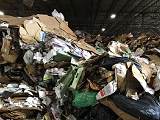Most people have heard the news of China’s 2018 National Sword policy, and how this is negatively impacting recycling markets throughout the world. You may not be aware of how and why this is impacting single stream recycling programs, not only for companies but also for nationwide U.S. municipal programs.
Single stream recycling began as a way to “increase” the volume of material being recycled. It was proposed as the model program, giving end-users the ease of tossing all recyclable materials into one bin, thereby eliminating the need to separate. Essentially the message was: “Mix it all together and we’ll separate the materials into the proper recyclable commodities for you later!” Sounds like a great idea, right?

We’re not quite sure who came up with the original idea of single stream recycling, but the waste management industry was all over it, promoting this to every city, town, and municipality that would listen shouting benefits like: “More efficient, fewer trucks on the road, increased material for volumes!” This eventually trickled down to being promoted for business, offering a container for “mixed recyclables”, or “single stream”. The industry was promoting this as fast as they could, “Sign here, we’ll take care of this for you!”
What was not promoted was the fact that a large portion of the material that was generated from these single stream programs could not being recycled. Single stream programs generated materials that were contaminated, sometime up to 20% or more: baled paper contained glass shards and plastic contamination; plastic contained paper and more glass; metals contained glass and plastics; glass could not be made clean enough for end markets. The cost to properly separate these commodities into clean end products was too high because it required too much time and labor. As a result, many US paper mills were subject to accepting material regardless of its cleanliness. They needed fiber and had no other way to acquire it. However, this contaminated material issue resulted in many small paper mills shutting their doors.
Single stream continued because we had the export markets. Manufacturing had moved off shore, and countries like China had huge capacity for fiber, plastics, and metals. Mixed recyclable material was shipped to these markets, as it was cost effective and most times the best or only option.
The downside is this material still had levels of contamination that had to be dealt with. A large portion of “recyclables” they were buying could not be recycled, and had to be disposed of instead. China woke up.
They decided they no longer wanted to be the dumping ground for containers full of material that were 20-30% trash. Why would they?
Municipalities and businesses are now scrambling for options and ideas. They want to recycle, but how?
Paper, plastic, aluminum, and steel can and should be recycled. If we want to continue to recycle, then it is up to us to make sure clean, marketable end products are generated. This can only be addressed with source-separated material.
Most people think the recycling industry is falling apart. Hopefully 3-5 years from now we will look back and realize that more focus is needed on the process of acquiring properly sorted, clean recyclable material and the education and support end users to make that happen. We need investment in both a domestic and foreign remanufacturing industry, and to create long term viable markets for our clean, properly sorted recyclable commodities. If you have any questions or concerns on your business’s options an recycling needs, contact us today.

